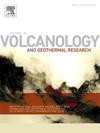Volcanic history and magma systems of Lake Monoun Polygenetic Maar, Noun Plain, Western part of the Cameroon Volcanic Line: Constraints from stratigraphy, chronology and geochemistry
IF 2.4
3区 地球科学
Q2 GEOSCIENCES, MULTIDISCIPLINARY
Journal of Volcanology and Geothermal Research
Pub Date : 2025-01-10
DOI:10.1016/j.jvolgeores.2025.108265
引用次数: 0
Abstract
Lake Monoun (LM) is a maar volcano located on the Cameroon Volcanic Line in West-Central Africa. In 1984, a limnic eruption occurred at LM, releasing large amounts of magmatic CO2 gas that had accumulated in the lake. The CO2 gas asphyxiated 37 people in the surrounding area. Despite this hazard, the volcanic history of LM maar remains unknown. This study presents the first comprehensive results of lithostratigraphy, physical volcanology, 14C dating and petrology of LM eruptive products. The lake has a WSW-ENE-aligned morphology with three main craters, the walls of which expose tephra and lava that can be divided into 5 stratigraphic units (A, B, C, D, and E from bottom to top). Unit A, a pyroclastic surge deposit in the NW, was produced by a phreatomagmatic eruption and deposited on a thick (ca.170 cm) paleosol developed on granitic basement. The paleosol yields a 14C age of ca 1.3 cal. ka. Units B (weathered scoria fall) and C (lava flow) in the NW part of the lake were respectively produced by strombolian and effusive eruptive activities. The SE side consists of unit D (scoria fall) a product of violent strombolian activity and unit E (voluminous surge) deposited by phreatomagmatic activity. The surge deposits of units A and E are rich in lithic fragments such as granite and lava, indicating subterranean excavation of country (accidental) and volcanic (accessory) rocks. A short time break represented by thin (ca. 15 cm, 0.1–0.3 cal. ka) paleosol can be recognized between units A and E in the distal facies. Based on the temporal and spatial distribution of these deposits, the eruption history of LM can be grouped into two stages. The first stage led to the development of the western and central craters and is recorded by units A to C in the NE section. The second stage proceeded after a short hiatus represented by the thin paleosol and a shift of the eruptive locus to the SE part of the lake. This gave rise to the largest eastern crater characterized by well-preserved units D and E. The LM case study reveals a potential time-space evolutionary pathway for crater formation, implying a polygenetic origin. Juvenile materials from the units are basanitic in composition with narrow chemical variation, suggesting a common magma system through the two stages. Silica content gradually increases from units A to E (SiO2 = 43.4 to 45.8 wt%), suggesting that the magma was differentiated with time (from units A to E) and tapped from the whole part of the chamber at unit E. Accessory lava fragments in units A and E display three distinct geochemical trends, composed of alkali and subalkaline basalts, implying the presence of diverse magma systems around the area prior to the maar formation.
喀麦隆火山线西段名词平原Monoun多生Maar湖火山历史与岩浆体系:地层学、年代学和地球化学约束
莫农湖(LM)是一座马尔火山,位于非洲中西部的喀麦隆火山线上。1984年,LM发生了一次湖泊喷发,释放了大量积聚在湖中的岩浆二氧化碳气体。二氧化碳气体导致周围37人窒息。尽管有这样的危险,马勒岛的火山历史仍然是未知的。本文首次对LM喷发产物的岩石地层学、物性火山学、14C测年和岩石学进行了综合研究。湖呈wsw - ene型排列,有三个主要的火山口,火山口壁暴露出火山和熔岩,从下到上可分为5个地层单元(a、B、C、D、E)。A单元为火山碎屑涌动矿床,形成于火山喷发,沉积于花岗岩基底上厚(约170 cm)的古土壤上。古土壤的14C年龄约为1.3 cal. ka。湖西北部的B单元(风化渣落)和C单元(熔岩流)分别是由暴喷发活动和喷涌喷发活动形成的。东侧由D单元(岩屑落)和E单元(体积涌流)组成,D单元是剧烈的激流活动的产物,E单元是由呼吸岩浆活动沉积的。A单元和E单元的涌动矿床富含花岗岩、熔岩等岩屑,表明其地下开挖为乡村(偶然)和火山(附属)岩石。在远端相A单元和E单元之间可识别出以薄层古土壤(约15 cm, 0.1 ~ 0.3 cal. ka)为代表的短时间断裂。根据这些沉积物的时空分布,可以将LM的喷发历史划分为两个阶段。第一阶段是西部和中部环形山的发育阶段,记录在东北剖面的A至C单元。第二阶段是在短暂的间歇期之后进行的,以古土壤变薄和喷发地点向湖的东南部移动为代表。这就产生了最大的东部陨石坑,其特征是保存完好的D和e单元。LM案例研究揭示了陨石坑形成的潜在时空进化途径,暗示了多成因的起源。两个单元的岩浆幼体成分均为玄武质,化学成分变化不大,表明两个阶段存在共同的岩浆体系。石英含量从A单元到E单元逐渐增加(SiO2 = 43.4 ~ 45.8 wt%),表明岩浆随时间分化(从A单元到E单元),在E单元从整个岩浆室流出,A和E单元的附属熔岩碎片显示出3种不同的地球化学趋势,由碱性和亚碱性玄武岩组成,表明该地区在岩浆形成之前存在不同的岩浆系统。
本文章由计算机程序翻译,如有差异,请以英文原文为准。
求助全文
约1分钟内获得全文
求助全文
来源期刊
CiteScore
5.90
自引率
13.80%
发文量
183
审稿时长
19.7 weeks
期刊介绍:
An international research journal with focus on volcanic and geothermal processes and their impact on the environment and society.
Submission of papers covering the following aspects of volcanology and geothermal research are encouraged:
(1) Geological aspects of volcanic systems: volcano stratigraphy, structure and tectonic influence; eruptive history; evolution of volcanic landforms; eruption style and progress; dispersal patterns of lava and ash; analysis of real-time eruption observations.
(2) Geochemical and petrological aspects of volcanic rocks: magma genesis and evolution; crystallization; volatile compositions, solubility, and degassing; volcanic petrography and textural analysis.
(3) Hydrology, geochemistry and measurement of volcanic and hydrothermal fluids: volcanic gas emissions; fumaroles and springs; crater lakes; hydrothermal mineralization.
(4) Geophysical aspects of volcanic systems: physical properties of volcanic rocks and magmas; heat flow studies; volcano seismology, geodesy and remote sensing.
(5) Computational modeling and experimental simulation of magmatic and hydrothermal processes: eruption dynamics; magma transport and storage; plume dynamics and ash dispersal; lava flow dynamics; hydrothermal fluid flow; thermodynamics of aqueous fluids and melts.
(6) Volcano hazard and risk research: hazard zonation methodology, development of forecasting tools; assessment techniques for vulnerability and impact.

 求助内容:
求助内容: 应助结果提醒方式:
应助结果提醒方式:


